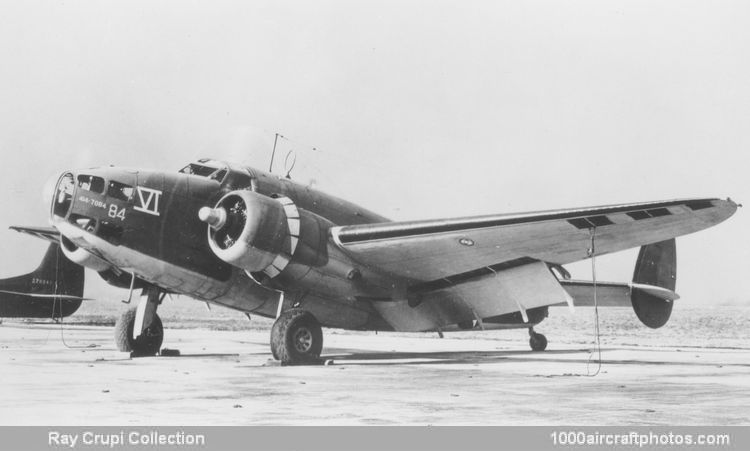06/30/2015. Remarks by Johan Visschedijk: "After President Roosevelt had signed on March 11, 1941, the Lend-Lease Bill, outstanding British contracts for Hudsons – as well as other aircraft types – were taken over under Department of the Army contracts and these 1,302 aircraft were produced with USAAF designations.
A-28-LO: Assigned USAAF designation and serials 41-23171 to 41-23222 for contractual purposes and powered by Pratt & Whitney R-1830-45s (the USAAF version of the Twin Wasp SC3-G), 52 Lockheed Model 414-08-10 aircraft (c/n 414-6030 to 414-6081) were delivered to the RAAF with which they served serialed A16-101 to A16-152 under the designation Hudson Mk.IVA.
A-28A-LO: Powered by 1,200 hp R-1830-67s (Chevrolet-built military version of the Twin Wasp S3C4-G), the 450 Lockheed Model 414-17-11 aircraft (42-6582 to 42-6681 and 42-46937 to 42-47286, c/n 414-6757 to 414-7206) were intended for British Commonwealth air forces and were also given the British military serials EW873 to EW972 and FK381 to FK730. They were delivered as Hudson Mk.VIs to the RAF (410 aircraft, of which at least three were transferred to the USAAF, and one went to Portugal's Aviação Naval), the RCAF (36 aircraft which retained their British serials) and the RNZAF (four aircraft, serialed NZ2091 to NZ2094). A number of RAF machines had their armament removed and were operated as Hudson C.VI transports.
A-29-LO: Whereas the A-28s and A-28As had Pratt & Whitney engines, the A-29s and A-29As had 1,200 hp Wright R-1820-87 engines. The 616 Lockheed Model 414-56-03 were designated Hudson Mk.IIIAs in Commonwealth service. When originally ordered by the British, these aircraft had been assigned serials BW361 to BW766, BW768 to BW777 and FH167 to FH366; however, upon becoming Lend-Lease items they became A-29-LOs, serialed 41-23223 to 41-23628 (c/n 414-5988 to 414-6029, 414-6082 to 414-6445), 41-23630 to 41-23639 (c/n 414-6447 to 414-6456) and 41-36968 to 41-37167 (c/n 414-6457 to 414-6456).
The first twenty aircraft were delivered to the US Navy as PBO-1s (BuNos. 03842 to 03861); the remaining aircraft went to the RAF and RCAF (32 and 133 aircraft, respectively, with their original British serials), the RAAF (41 aircraft), the RNZAF (14 aircraft), the Chinese AF (23 aircraft) and the USAAF (153 aircraft) with a flexible 0.50 in (12.7 mm) machine gun in an open dorsal position; 24 of the 161 USAAF aircraft became A-29B-LOs.
A-29A-LO: Differing from the A-29s in having a convertible interior for troop transport, but retaining their armament and Hudson Mk.IIIA designation, the 184 aircraft of this type had both British and US serials assigned (BW767, 41-23629, c/n 414-6446; FH367 to FH466, 41-37168 to 41-37267, c/n 414-6657 to 414-6756; FK731 to FK813, 42-47287 to 42-47369, c/n 414-7507 to 414-7589). The RAF received 89 of these aircraft, the RAAF took delivery of 65 machines, the RNZAF obtained 23 aircraft, the RCAF was the recipient of four aircraft and the Chinese AF added three A-29A-LOs to its inventory of twenty-three A-29-LOs.
A-29B-LO: This were the 24 A-29-LOs retained by the USAAF, converted under this designation as photographic-survey aircraft.
The pictured aircraft was delivered to the RAF as a Hudson Mk.VI (serialed FK608), and initially it was used as a target tug at Bowman Field, Louisville, Kentucky, USA. Subsequently it was assigned to the Mediterranean Allied Tactical Air Forces Communication Flight which was formed on January 1, 1944 at Bari, Italy; the unit disbanded on June 1, 1945 at Peretola, Italy. The aircraft was lost at Peretola on February 19, 1945, when it spun into the ground after an engine failed on take off."
